
Francisco José de Goya y Lucientes was a Spanish romantic painter and printmaker. He is considered the most important Spanish artist of the late 18th and early 19th centuries. His paintings, drawings, and engravings reflected contemporary historical upheavals and influenced important 19th- and 20th-century painters. Goya is often referred to as the last of the Old Masters and the first of the moderns.

Romanticism was an artistic and intellectual movement that originated in Europe towards the end of the 18th century. The purpose of the movement was to advocate for the importance of subjectivity, imagination, and appreciation of nature in society and culture in response to the Age of Enlightenment and the Industrial Revolution.

Jean-Louis André Théodore Géricault was a French painter and lithographer, whose best-known painting is The Raft of the Medusa. Despite his short life, he was one of the pioneers of the Romantic movement.

Romanticism in the visual arts, originating in the 1760s, marked a shift towards depicting wild landscapes and dramatic scenes, reflecting a departure from classical artistic norms. This movement emphasized the sublime beauty of nature, the intensity of human emotions, and the glorification of the past, often through the lens of national identity and historical events.

The Neue Pinakothek is an art museum in Munich, Germany. Its focus is European Art of the 18th and 19th centuries, and it is one of the most important museums of art of the nineteenth century in the world.
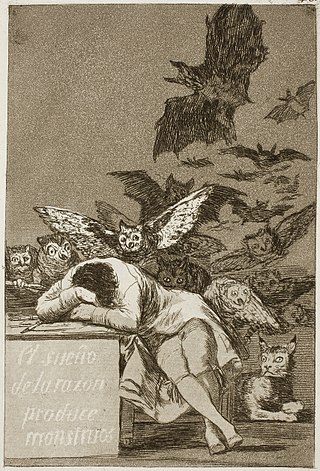
Los caprichos is a set of 80 prints in aquatint and etching created by the Spanish artist Francisco Goya in 1797–1798, and published as an album in 1799. The prints were an artistic experiment: a medium for Goya's condemnation of the universal follies and foolishness in the Spanish society in which he lived. The criticisms are far-ranging and acidic; the images expose the predominance of superstition, the ignorance and inabilities of the various members of the ruling class, pedagogical short-comings, marital mistakes and the decline of rationality. Some of the prints have anticlerical themes. Goya described the series as depicting "the innumerable foibles and follies to be found in any civilized society, and from the common prejudices and deceitful practices which custom, ignorance or self-interest have made usual".
The year 1800 in art is often estimated to be the beginning of the change from the Neoclassicism movement, that was based on Roman art, to the Romantic movement, which encouraged emotional art and ended around 1850 and brought forth a new era of artistic exploration. Artists of that time departed from traditional norms, embracing fresh ideas and diverse subjects. This era blended classical principles with innovative concepts, capturing both contemporary life and historical stories. The art in 1800 set the foundation for later 19th-century movements, inspiring a new era of artistic creativity that continued to shape the course of artistic development for years to follow.
Events from the year 1795 in art.
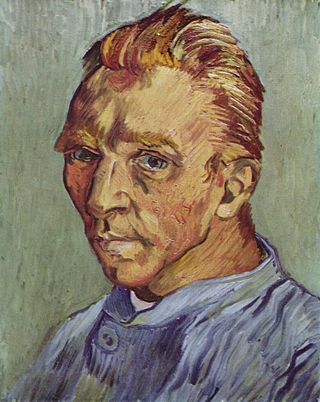
A self-portrait is a portrait of an artist made by themselves. Although self-portraits have been made since the earliest times, the practice of self-portraiture only gaining momentum in the Early Renaissance in the mid-15th century that artists can be frequently identified depicting themselves as either the main subject, or as important characters in their work. With better and cheaper mirrors, and the advent of the panel portrait, many painters, sculptors and printmakers tried some form of self-portraiture. Portrait of a Man in a Turban by Jan van Eyck of 1433 may well be the earliest known panel self-portrait. He painted a separate portrait of his wife, and he belonged to the social group that had begun to commission portraits, already more common among wealthy Netherlanders than south of the Alps. The genre is venerable, but not until the Renaissance, with increased wealth and interest in the individual as a subject, did it become truly popular.

Saturn Devouring His Son is a painting by Spanish artist Francisco Goya. It is traditionally considered a depiction of the Greek myth of the Titan Cronus, whom the Romans called Saturn, eating one of his children out of fear of a prophecy by Gaea that one of his children would overthrow him. The work is one of the 14 so-called Black Paintings that Goya painted directly on the walls of his house sometime between 1820 and 1823. It was transferred to canvas after Goya's death and is now in the Museo del Prado in Madrid.

The Disasters of War is a series of 82 prints created between 1810 and 1820 by the Spanish painter and printmaker Francisco Goya (1746–1828). Although Goya did not make known his intention when creating the plates, art historians view them as a visual protest against the violence of the 1808 Dos de Mayo Uprising, the subsequent cruel war that ended in Spanish victory in the Peninsular War of 1808–1814 and the setbacks to the liberal cause following the restoration of the Bourbon monarchy in 1814. During the conflicts between Napoleon's French Empire and Spain, Goya retained his position as first court painter to the Spanish crown and continued to produce portraits of the Spanish and French rulers. Although deeply affected by the war, he kept private his thoughts on the art he produced in response to the conflict and its aftermath.
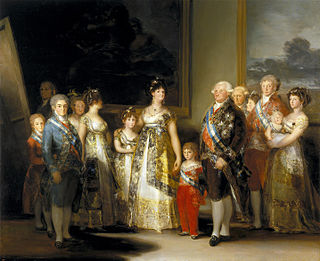
Charles IV of Spain and His Family is an oil-on-canvas group portrait painting by the Spanish artist Francisco Goya. He began work on the painting in 1800, shortly after he became First Chamber Painter to the royal family, and completed it in the summer of 1801.

The Sleep of Reason Produces Monsters or The Dream of Reason Produces Monsters is an aquatint by the Spanish painter and printmaker Francisco Goya. Created between 1797 and 1799 for the Diario de Madrid, it is the 43rd of the 80 aquatints making up the satirical Los caprichos.

Yard with Lunatics is a small oil-on-tinplate painting completed by the Spanish artist Francisco Goya between 1793 and 1794. Goya said that the painting was informed by scenes of institutions he had witnessed as a youth in Zaragoza.

Unfortunate Events in the Front Seats of the Ring of Madrid, and the Death of the Mayor of Torrejón is the name given to an etching with burnished aquatint, drypoint and burin on paper by the Spanish painter and printmaker Francisco Goya.

A Pilgrimage to San Isidro is one of the Black Paintings painted by Francisco de Goya between 1819–23 on the interior walls of the house known as Quinta del Sordo that he purchased in 1819. It probably occupied a wall on the first floor of the house, opposite The Great He-Goat.
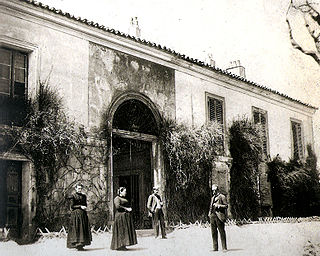
The Black Paintings is the name given to a group of 14 paintings by Francisco Goya from the later years of his life, likely between 1819 and 1823. They portray intense, haunting themes, reflective of both his fear of insanity and his bleak outlook on humanity. In 1819, at the age of 72, Goya moved into a two-story house outside Madrid that was called Quinta del Sordo. Although the house had been named after the previous owner, who was deaf, Goya too was nearly deaf at the time as a result of an unknown illness he had suffered when he was 46. The paintings originally were painted as murals on the walls of the house, later being "hacked off" the walls and attached to canvas by owner Baron Frédéric Émile d'Erlanger. They are now in the Museo del Prado in Madrid.

Self-Portrait with Dr Arrieta is the English title given to a painting by Spanish artist Francisco Goya. The work is an oil on canvas, painted in 1820, and is currently held in the Minneapolis Institute of Art, Minnesota. Many scholars have seen religious themes in the work. Other interpretations compare and contrast the painting with Goya's series of Black Paintings, contextualizing the work within his career at large.
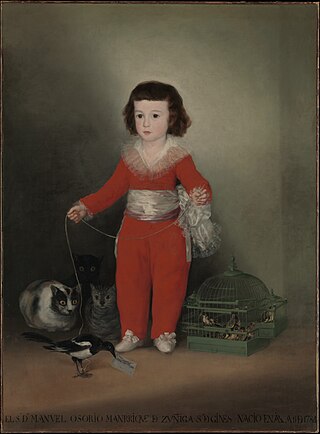
Manuel Osorio Manrique de Zúñiga is a large full-length portrait in oil painted in 1787–88 by the Spanish artist Francisco Goya. It depicts a boy three or four years of age, standing in red clothes, with birds and cats. It is also known as Goya's "Red Boy". It was described by art historian Claus Virch in 1967 as "one of the most appealing and successful portraits of children ever painted, and also one of the most famous". The painting has been held by the Metropolitan Museum of Art, in New York, since 1949.

The Duchess of Alba and "la Beata" is a oil-on-canvas painting by the Spanish artist Francisco Goya, from 1795.

















